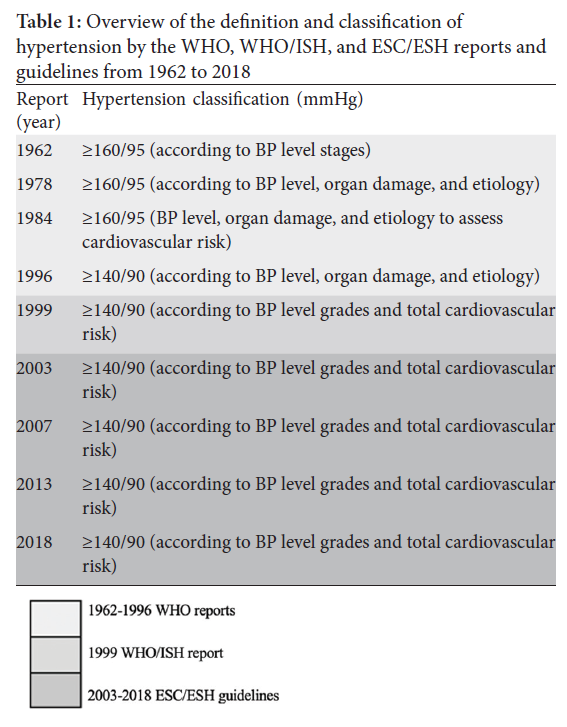The Evolution of Hypertension Guidelines: A Global and European Perspective with a Focus on Classification of Hypertension (Review)
Main Article Content
Abstract
Hypertension guidelines play an important role in offering “balanced information” to guide clinicians in clinical decisions and have contributed to improving hypertension management over time. However, the process of guideline development is complex and subject to vulnerabilities. Consequently, key aspects of hypertension management remain highly debated. Here, we evaluate the evolution in hypertension management and identify limitations and inconsistencies in guidelines with a focus on definitions and classifications of hypertension. We analyzed guidelines from the World Health Organization (WHO) from years 1962 to 1999 and the European Society of Cardiology and European Society of Hypertension from years 2003 to 2018 to obtain a global and European perspective. Overall, it is understood that recommendations for hypertension management have and will continue to be subject to modifications with time, especially in an ever-evolving field of hypertension research with emerging evidence. Therefore, these inherent complexities and changes should be embraced, while bearing in mind that guidelines should always be based on up-to-date and robust evidence.
DOI: 10.15713/ins.johtn.0224
Metrics
Article Details

This work is licensed under a Creative Commons Attribution-NonCommercial-ShareAlike 4.0 International License.
All open access articles published in the journal are distributed under the terms of the CC-BY-NC-SA 4.0 license (Creative Commons Attribution-Non-commercial 4.0 International License) which permits unrestricted use, distribution, and reproduction in any medium, for non-commercial purposes, provided the original work is properly cited. Under Creative Commons, authors retain copyright in their articles.
References
National Institute for Health and Care Excellence (NICE) Guideline [NG136]. Hypertension in Adults: Diagnosis and Management (NG136); 2019.
Kotchen TA. Developing hypertension guidelines: An evolving process. Am J Hypertens 2014;27:765-72.
Jennings GL, Touyz RM. Hypertension guidelines: More challenges highlighted by Europe. Hypertension 2013;62:660-5.
Ettehad D, Emdin CA, Kiran A, Anderson SG, Callender T, Emberson J, et al. Blood pressure lowering for prevention of cardiovascular disease and death: A systematic review and meta-analysis. Lancet 2016;387:957-67.
Gross F, Pisa Z, Strasser T, Zanchetti A. Management of Arterial Hypertension: A Practical Guide for the Physician and Allied Health Workers. Geneva: World Health Organization; 1984.
Williams B, Mancia G, Spiering W, Rosei EA, Azizi M, Burnier M, et al. 2018 ESC/ESH guidelines for the management of arterial hypertension. Eur Heart J 2018;39:3021-104.
World Health Organisation. Arterial Hypertension and Ischaemic Heart Disease (Preventive Aspects): Report of a WHO Expert Committee. Geneva: World Health Organisation; 1962.
World Health Organisation. Arterial Hypertension: Report of a WHO Expert Committee. Geneva: World Health Organisation; 1978.
World Health Organisation. Hypertension Control: Report of a WHO Expert Committee. Geneva: World Health Organisation; 1996.
European Society of Hypertension-European Society of Cardiology Guidelines Committee. 2003 European society of hypertension and European society of cardiology guidelines for the management of arterial hypertension. J Hypertens 2003;21:1011-53.
Mancia G, de Backer G, Dominiczak A, Cifkova R, Fagard R, Germano G, et al. 2007 guidelines for the management of arterial hypertension. J Hypertens 2007;25:1105-87.
Mancia G, Fagard R, Narkiewicz K, Redón J, Zanchetti A, Böhm M, et al. 2013 ESH/ESC guidelines for the management of arterial hypertension. J Hypertens 2013;31:1281-357.
Chalmers J, MacMahon S, Mancia G, Whitworth J, Beilin L, Hansson L, et al. 1999 World Health Organization-international society of hypertension guidelines for the management of hypertension. Clin Exp Hypertens 1999;21:1009-60.
Fagard RH, van den Broeke C, de Cort P. Prognostic significance of blood pressure measured in the office, at home and during ambulatory monitoring in older patients in general practice. J Hum Hypertens 2005;19:801-7.
Whitworth JA. 2003 World Health Organization (WHO)/ international society of hypertension (ISH) statement on management of hypertension. J Hypertens 2003;21:1983-92.
Collins R, MacMahon S. Blood pressure, antihypertensive drug treatment and the risks of stroke and of coronary heart disease. Br Med Bull 1994;50:272-98.
Sytkowski PA, D’Agostino RB, Belanger AJ, Kannel WB. Secular trends in long-term sustained hypertension, longterm treatment, and cardiovascular mortality. Circulation 1996;93:697-703.
Devereux RB. Prognostic significance of left ventricular mass change during treatment of hypertension. JAMA 2004;292:2350-6.
Ibsen H, Olsen MH, Wachtell K, Borch-Johnsen K, Lindholm LH, Mogensen CE, et al. Reduction in albuminuria translates to reduction in cardiovascular events in hypertensive patients. Hypertension 2005;45:198-202.
Whelton PK, Carey RM, Aronow WS, Casey DE, Collins KJ, Himmelfarb CD, et al. 2017 ACC/AHA/AAPA/ABC/ACPM/ AGS/APhA/ASH/ASPC/NMA/PCNA guideline for the prevention, detection, evaluation, and management of high blood pressure in adults: A report of the American college of cardiology/American heart association task force on clinical practice guidelines. Hypertension 2018;71:1269-324.
Unger T, Borghi C, Charchar F, Khan NA, Poulter NR, Prabhakaran D, et al. 2020 International society of hypertension global hypertension practice guidelines. Hypertension 2020;75:1334-57.
Poulter NR, Castillo R, Charchar FJ, Schlaich MP, Schutte AE, Tomaszewski M, et al. Are the American heart association/ american college of cardiology high blood pressure guidelines fit for global purpose? Thoughts from the international society of hypertension. Hypertension 2018;72:260-2.
Zanchetti A. The hypertensive patient with multiple risk factors is treatment really so difficult? Am J Hypertens 1997;10:223S-9.
D’Agostino RB, Grundy S, Sullivan LM, Wilson P. Validation of the Framingham coronary heart disease prediction scores. JAMA 2001;286:180-7.
Conroy R. Estimation of ten-year risk of fatal cardiovascular disease in Europe: The SCORE project. Eur Heart J 2003;24:987- 1003.
Cooney MT, Dudina AL, Graham IM. Value and limitations of existing scores for the assessment of cardiovascular risk. J Am Coll Cardiol 2009;54:1209-27.
Aktas MK. Global risk scores and exercise testing for predicting all-cause mortality in a preventive medicine program. JAMA 2004;292:1462-8.
Graham R, Mancher M, Wolman DM, Greenfield S, Steinberg E, editors. Clinical Practice Guidelines We Can Trust. Washington, DC: National Academies Press; 2011.
